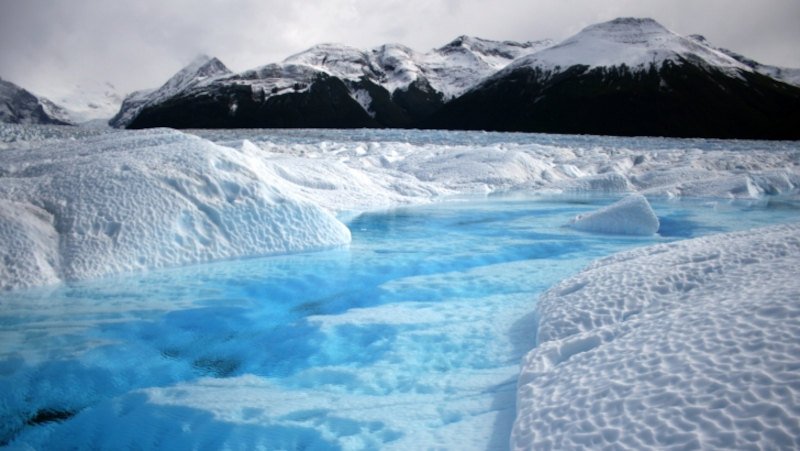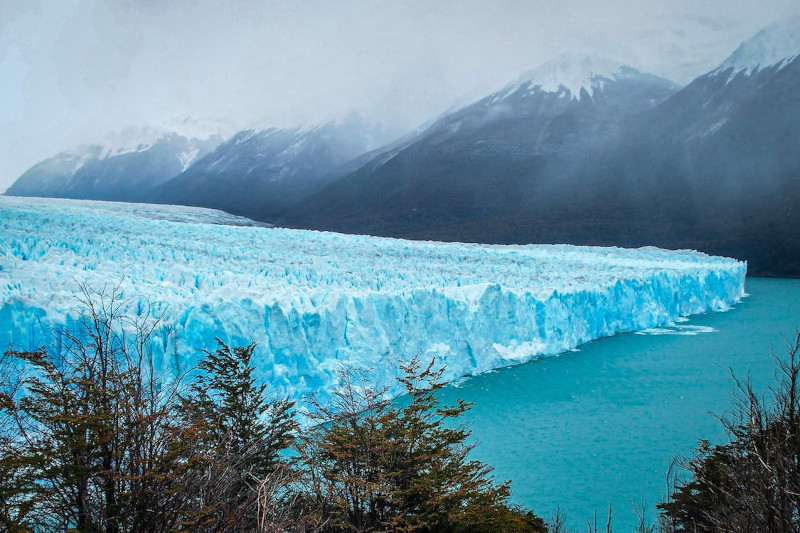Perito Moreno Glacier Facts
- This breathtaking marvel of natural forces remains most frequently referred to by the english language term of Perito Moreno Glacier. The marvel has other names, though, in other tongues. Those include the moniker of Glaciar Perito Moreno.
- No matter which of these appellations one chooses to use when referring to it, the site represents a natural wonder. It also holds a place of note among any list of similar features around the globe. That’s because, unlike most, this one’s remaining stable.
- Local populations of Indigenous Peoples long knew of its existence, of course. Records indicate that the first known outsider to spot it, however, was Juan Tomás Rogers. The British navy captain, of the Chilean Navy, noted sighting the glacier in the year 1879.
- Thankfully, the Perito Moreno Glacier resides within the confines of what’s now the Los Glaciares National Park. There, however, it understandably forms one of the most popular attractions in the park. That status, though, brings its own share of concerns.
- Officials make every effort to provide for the safety of visitors. They also strive to ensure that no human activities endanger the stability of the glacier itself. Although stable for now, the ongoing effects of climate change might one day change that.
Related Articles

Perito Moreno Glacier Physical Description
The mesmerizing Perito Moreno Glacier represents a true marvel of Nature. As such, it immediately captures the attention of those who visit the site. Its dazzling white beauty isn’t the only reason for this, though that’s certainly a quality it holds in abundance.
This captivating creation of environmental factors also boasts some astonishing measurements, as well. Extending down from the nearby mountains from which it springs, this marvel stretches a total distance along its length of approximately 19 mi (30 km).
Yet, that’s only the beginning of the many impressive attributes it has to offer the viewer. Although the width of this massive ice flow naturally varies along its distance, overall it achieves an average span of roughly 3.1 mi (5 km). It narrows near the terminus, though.
Taken together, these dimensions provide it with yet another astounding statistic. Given those, this body of frozen water has a total surface area equaling about 97 sq mi (250 sq km). While not the largest of its kind on earth, it’s nonetheless worthy of appreciation.
The magnficent Perito Moreno Glacier further holds one final statistic to dazzle the explorer. That pertains to its thickness. Like its other aspects, this also changes from location to location, of course. A mean thickness, however, totals a remarkable 558 ft (170 m).
Perito Moreno Glacier Location, History, and Ecology
The mind-boggling beauty of Perito Moreno Glacier formed in a general part of the world renowned for its natural beauty. The exact region of the globe it sits in might surprise you, though. That’s because it formed as part of what’s now the continent of South America.
Better known for its plethora of tropical settings than wintry one’s, the landmass nonetheless serves as home to this feature. In fact, this gorgeous flow of ice sctually represents just one of 48 separate glaciers originating from a single source on the continent.
That’s the gigantic Southern Patagonian Ice Field. This itself sits within the national boundaries of two countries. Chile contains a small portion of the field, while Argentina contains the majority. It’s the latter country that plays host to this wonder of Nature.
The precise time period at which this extraordinary glacier formed remains unknown. Its origins lie somewhere in the span of time between roughly 2.6 million and 11,7000 years ago. The second of these times marked the approximate end of the last great ice age.
Due to the slow but inexorable advance of Perito Moreno Glacier, the ice occasionally ruptures in dramatic fashion. The only recorded of these occurred in modern times. Since 1917, a total of 26 of these fantastic events have been recorded by science and observers.
Yet this eerily beautiful site holds one more amazing fact. Despite the inhospitable conditions, the glacier itself actually plays host to a living species! A small stonefly inhabits the glacier. It spends its entire life on the ice, and feeds on bacteria brought by the wind.
Features Sharing Its Region
Check out our other articles on 5 Amazing Moths of Asia, Eastern Gray Squirrel, Okefenokee Swamp, Lime Butterfly, Fire Salamander, Sicilian Fir, Knysna Seahorse, Philippine sailfin lizard

